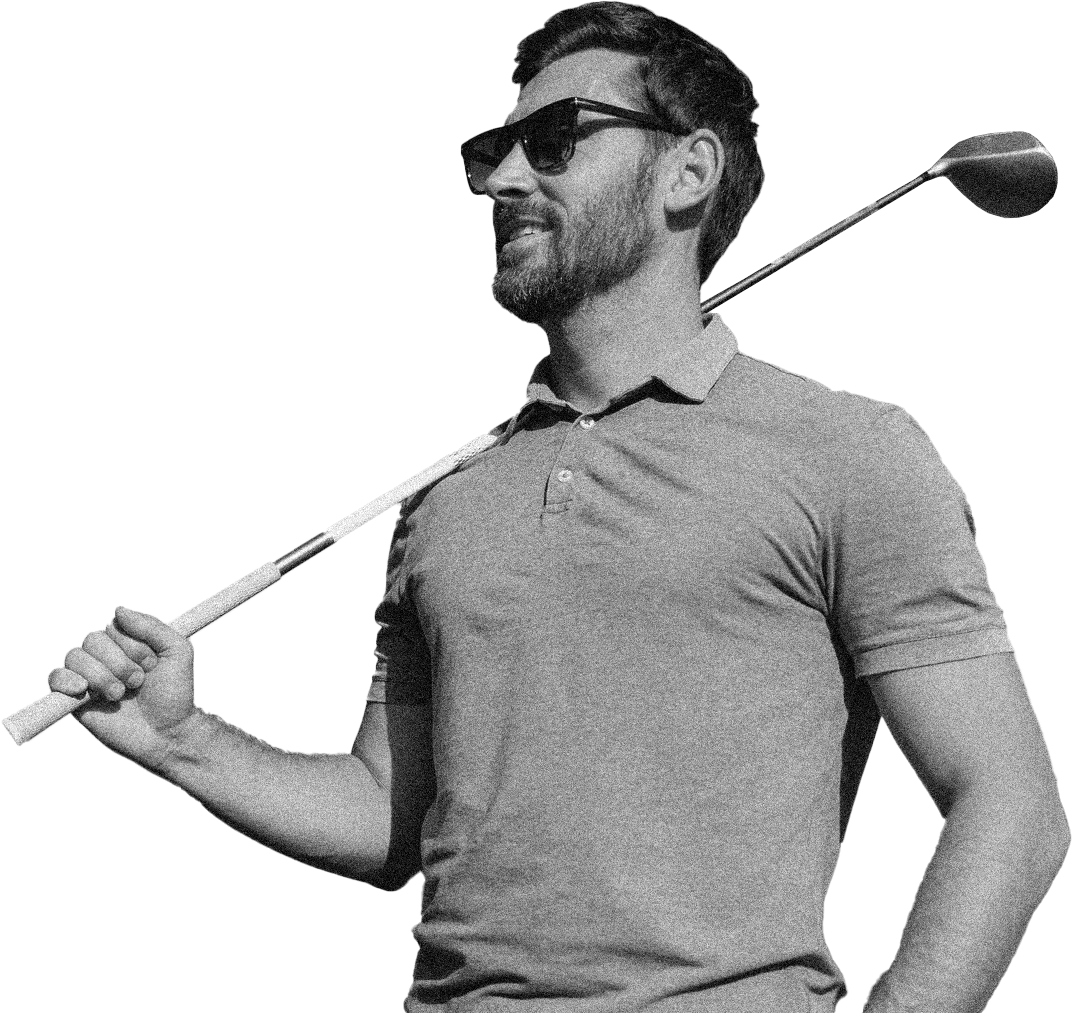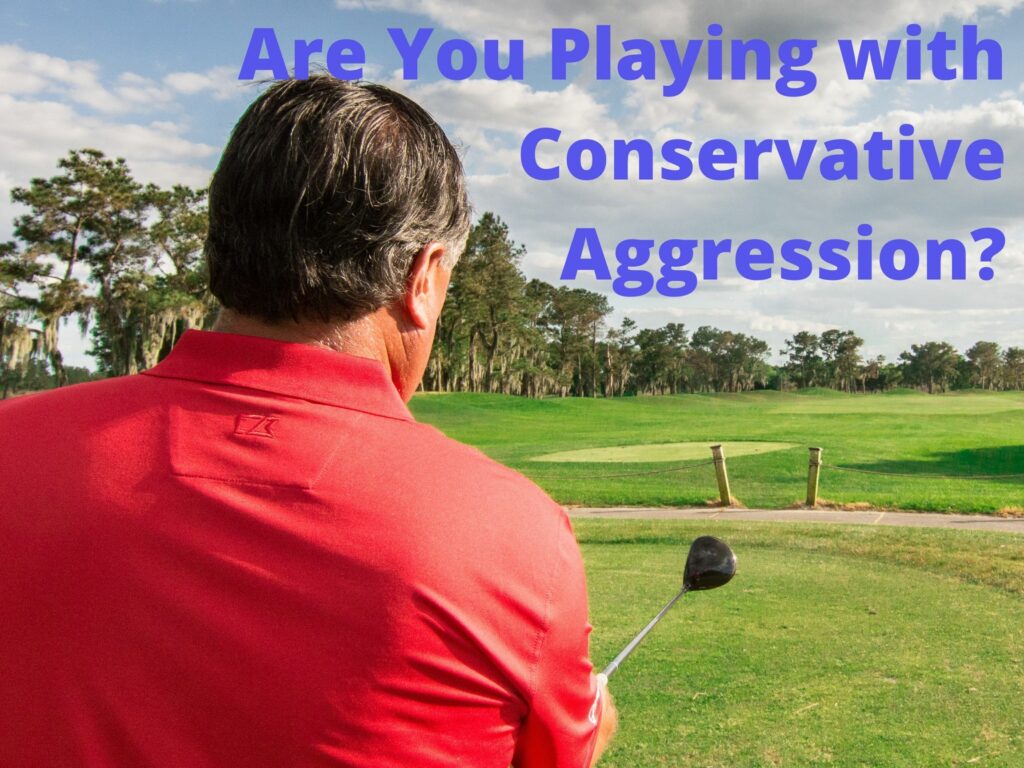Conservative Aggression
Chances are you think of the term “conservative aggression” as a strategy you might use to invest in the stock market. Or a strategy you use at the health club when exercising..
You’ll be conservative with your choices of stocks or exercise but aggressive with how with the execution of each. Within the financial world, it’s called risk tolerance. You’ll perform your due diligence before picking a stock or mutual fund. and then go all in when its time, and the choice meets your expectations and the end goal of why you’re investing. At the health club you’ll conservatively start an exercise program that meets your current fitness level and allows you the comfort of knowing any exercise you do will not hurt you.
Why wouldn’t a conservative aggressive approach to your golf game provide you more opportunity to shoot a better score?
On the Golf Course You Choose the Opposite
I bet on the golf course you find yourself doing the opposite. You’ll make baseless ultra-aggressive decisions and expect to perform those decision, realizing as you swing that you better “slow down” to insure a result. In essence, your ultra aggressive decision leads to a mistake. You recognize it too late. Yet you’ll go ahead and execute a swing, attempting to correct mistakes versus swinging without fear.
In addition, you’ll use the same baseless, ultra-aggressive process to get yourself out of the first mistake you made. And as predicted, it too leads to a mistake, a 2nd mistake trying to undo the 1st one. Ever hear of compounding a mistake by making another?
If this sounds like you and your game, let’s convince you of reversing the two words. Conservative confirms first. Then aggression. Doing so will pay big dividends to your game both short and long term.
Conservative aggression is not about being fearful. It’s about conquering the unknown before venturing into it. Once the decision is made to venture into it, your commitment and confidence level provide you the comfort to conquer your fear. As well is feel free to execute the golf swing you’re capable of making.
A Common Story of What Conservative Aggression is Not
A lot of the non-competitive clients I coach do not have a process of making a great decision on the golf course. They claim because their not competitive they don’t need it. Often they’ll try golf shots that they’re not capable of. Partially due to lacking the skills necessary to make the swing they think they can execute. When I ask each client what they were thinking about in relation to the shot they just failed at pulling off, I normally receive different but similar answers. Such as “because I saw the shot on TV and wanted to try.” Sometimes the answer is they tried a shot just to try it. And sometimes the answer is ” I don’t know why I tried that shot.”
I categorize these answers and ways of thinking as ultra-aggressive. Ultra-aggressive in the sense there’s no basis to the decision of the shot each chose. But, standing over the ball having made an ultra-aggressive decision, the same golfer questions themselves as they begin the swing, whether they’ll pull the shot off. This in turn leads to them becoming very ultra-conservative with how they’ll swing, being very manipulative and over controlling of their swing.
Golf is a Game of Opposite
Conservative aggression is the opposite of the example above. It’s your ability to make a conservative decision prior to executing a swing. In turn, the conservative decision allows you to be normally aggressive as you swing. Let’s look at conservative aggressive process you can use with every shot throughout a round. Making a conservative decision first. Then lets examine how the conservative decision allows you to play aggressively within your own skill set.
Want a quick lesson about Conservative Aggression? Check out the accompanying video of this blog post.
Conservative Aggression Starts with Decisions
Conservative means you’re making conservative decisions based upon the tools you own and the skills you consistently execute. It means as you’re playing golf, the decisions you’re making prior to swinging are swings you can perform. It also means you’re avoiding the compounding of a mistake by making a second mistake.
Lies do not Lie
Decision making starts with where and how your golf ball lies on the golf course.
Making a decision about a tee shot is fairly easy. The opportunity to place the ball exactly where you want, and how you want, makes this decision easier than other lie decisions you face when you ball is in play. But once your ball is in play, lie dictates a lot of the other decisions you’ll need to make for each shot.
With a perfect lie, your decisions are easier. As more variables enter the equation that define your lie, making a decision about your lie conditions is of utmost importance. Do you have an uneven lie? Is the ball above or below your feet? Are you on a hard pan lie? Are you in deeper grass? Is your lie a combination of all these factors as well as others?
Your job making is deciding what will happen to the ball at impact based upon the lie conditions present. This determination is the basis for the decisions that follow. You can’t make a solid shot shape or club decision if you do not decide how the lie will affect the shot. Not recognizing this step, and not being conservative as you go about your making decisions based upon your lie, is where you most likely start compounding a mistake by making another one.
How Far Does Conservative Aggression Take Me?
The proximity of your golf ball to your intended target is the second phase of making a conservative decision. Considering the lie conditions, can you realistically reach your intended target? Or will you need a second shot from your current lie to reach your intended target? Lie conditions dictate whether you achieve clean contact between the golf club and the golf ball at impact.
With a perfect lie you can probably swing a club, with your stock swing, and reach your intended target. But a compromised lie will always force you to consider changing golf clubs. The change of golf club will also change how far the ball travels. However, just because you take less club doesn’t mean the ball will fly a shorter distance. Based on your lie it may go further than expected. Therefore, lie conditions are the priority.
What Does this Shot Look Like?
Based upon the lie condition and the distance of the shot you’re intending to play, what type of shot can you hit? This is the third phase of conservative decision making. Lie conditions have a greater influence upon your shot shape decision than you realize. However, the distance you intend to hit the shot, relative to other obstacles in your way, can alter your vision of what the shot should look like.
Beside the actual lie itself, what other factors play into the shot shape you choose? Is it low hanging branches of trees in front of you? Or a forced carry over a body of water? Sometimes the lie and desired distance do not match the shot shape you prefer. You may want to hit a certain shot shape. But because of the lie and where the ball is in relation to your target, your desired shot shape may not be a reasonable choice.
Why? Because you may not own the prerequisite skills to pull the shot off. Do you have the skills necessary to pull off the shot you’re intending? Better yet, do you even have an inventory of the golf skills you own? Or are you basing your shot shape decision upon skills you don’t own?
What Skills Do You Own?
The fourth and final phase of conservative decision making is choosing a shot your skills are capable of.
Often, I see my clients ignore this all together. They see a pro pull off an amazing shot on TV. And believe they can do the same. But they’ve never practiced the shot. And their lack of knowledge about the shot leaves them no clue of how to produce the shot. They never make practice swings within their pre-shot routine to rehearse the feelings needed to execute the shot. And the confidence in their skill needed to pull off the golf shot is questionable at best. Yet, they’ll stand over the ball and try to make the shot happen anyway. This is not a recipe for success on the golf course.
Based upon the lie and your skill set is how you’ll decide the best shot to hit. Not owning certain skills to pull off some shots is okay. It’s better to check your ego at the door and try a shot you know you have a high percentage of making happen. Doing so, you may sacrifice an extra stroke now. But in turn, you eliminate the big number on the scorecard. Why? Because you avoided an obvious weakness. As well you’ve avoided compounding a mistake by making another.
Am I Ready Yet?
Having gone through this 4-step process of making a conservative decision you should feel more comfortable with your decision. No matter where on the course you are, this process works. The process accounts for all variables in a logical and sequential order. And the process does not allow you to go on to the next step without making a confident decision at every step of the process.
Now you’ve made your decision. You’ve done so in a conservative way, taking into effect the lie, your abilities, the shot shape you want, and the club necessary to execute it. It’s now time to trust these decisions and execute the shot.
Commit to Aggression
Have you ever stood over a shot in felt uncomfortable? But went ahead and made the shot happen anyway? When this happens to my clients, they normally hit a poor shot. And I let them know in very certain terms, they just gave themselves permission to fail. Being uncomfortable, combined with hitting the shot anyway, was the direct cause of the poor shot.
If you’re not feeling comfortable, yet go ahead and make the swing, that’s not aggression. It’s stupidity. What’s the likelihood of you hitting the best shot possible if you’re not committed to make the shot happen? As in other phases of our life, we trust our gut instinct and make sure we’re comfortable with the decisions we make before executing any action. And in most cases if our gut tells us we’re uncomfortable, we normally back away from pulling the trigger for any action. So why is it any different in golf? If your gut feeling is uncomfortable, why go ahead and hit the shot? If you do, don’t you deserve to fail?
Conservative Aggression is Freedom!
The idea behind making a conservative decision is to allow you the freedom, comfort, and confidence to swing, your swing. Your best swings are thoughtless. Your best swings are smooth, not violent. Believe it or not, those swings represent the maximum or “normal” aggression you should feel with any golf swing. The ability to use your energies in a productive way to swing without thought, without hesitancy, produce aggressive swings.
To pull this off, your pre-shot routine must be good enough for you to feel comfortable over any shot. You most commonly think of your pre-shot routine as the chain of events you perform as you prepare to address the golf ball. It is in fact a “transition” from the decision-making process of a golf shot to the actual execution of a golf shot. Whether your routine is standing behind the ball or beside the ball, your routine must repeat itself for the transition to take place consistently.
Your pre-shot routine allows for your conservative shot decision to sink in and gain comfort. The pre-shot routine must provide an opportunity to rehearse the shot you’re intending to hit. It should account for your target and your ability to focus upon the target cleanly. And it should be a process that will allow you to set up correctly and stay in balance, regardless of the lie.
Time to Pull the Trigger
Once you make a conservative decision for any shot you’re intending to make, you can now play that shot aggressively. How many times have you stood over a golf shot uncommitted? And in turn thought your way through a swing? This is not how you play your best golf.
Once you’ve gone through the decision making and your pre-shot routine, you should feel comfortable and ready to make any golf swing you want. If not, back away and start from the beginning. Ensure the decision you made is a correct one for you.
If you’re ready to make the swing, what’s holding you back. There should be no hesitation. React with tempo and execute a good shot. Versus, trying so hard to create a shot that’s probably out of sync.
The entire process of making a decision is preparation in itself. Within your pre-shot routine you’re preparing. You’re preparing for how the shot should feel. How you should set up for the shot. Envisioning the shot as you make the practice swings. If you can check those boxes, then what’s preventing you from making the swing you chose?
Conclusion
Conservative Aggression allows you the freedom to play your best. You play your best golf when you can swing freely and easily. This occurs most often when you’re committed to the shot. You can’t commit to a shot if your decision is so aggressive, your gut feeling says you can’t pull off the shot. You must reverse the trend and the process.
Making a conservative decision, keeping in mind lie, distance, shot shape, and skills, will always produce a decision that leans on the conservative side of your abilities. Doing so supplies you comfort and confidence. In turn, producing commitment and trust in every shot your take, freeing yourself to trust your ability to play the shot aggressively, without thought or fear.
Try reversing your process. Give up the process of being aggressive with decisions and conservative with swinging the club. Conservative Aggression is always a better process to limit mistakes and feel more confident about yourself no matter the situation you face on the golf course.





